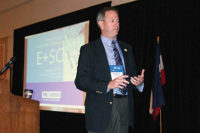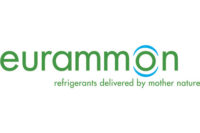No portion of refrigeration has been more cutting edge than the supermarket sector. Papers and presentations showcased at the most recent Food Marketing Institute Energy & Store Development Conference demonstrated the sector’s move away from high-global warming potential (GWP) refrigerants and toward more efficient equipment.
Alternative Refrigerants
Tim Anderson, principal engineer for Hussmann Corp., shared how some supermarket owners have paired new equipment with low- or no-GWP refrigerants.
“The goal is to compare and contrast HFC [hydrofluorocarbon], CO2, glycol, and propane refrigeration systems by explaining, from an equipment perspective, the strengths and weaknesses of each system and how supermarket operators can determine which system is right for their companies and cultures.”
He offered three main refrigerant choices: Synthetic HFCs such as R-134a and -407A; synthetic blends such as HFO-1234yf and HFO-1234ze; and natural refrigerants like R-744 (CO2), R-290 (propane), R-600a (isobutene), and R-717 (ammonia).
“There is no perfect solution,” he said. “Improving one thing always causes something else to get worse. For example, lowering the environmental impact often causes the blend to be flammable.” And, he noted: “The refrigerant choice cannot be separated from the system choice. For example, A2Ls [slightly flammable refrigerants] are not likely for centralized parallel direct expansion systems.”
The overriding issue, he stressed, is flammability. There are currently five flammability classifications: Class 1, with no flame propagation consisting of many existing HFCs and blends and CO2; Class 2L, with low flammability such as HFO-1234yf and R-32; Class 2, which is considered flammable, includes refrigerants such as R-152a; and Class 3, deemed highly flammable, includes hydrocarbons (HCs) R-290 and R-600a.
Designing a System
With all the options available in refrigerants and systems, it’s often up to store managers to determine which selection best fits their facilities.
Rob Arthur, an engineer with CTA Architects Engineers, said the in-house engineering team, equipment manufacturer, and a consulting engineer should help drive such a decision.
“The process involves building time into the schedule for full development, bringing all stakeholders together, and utilizing refrigeration consultants as the hub that receives, distributes, and coordinates with all stakeholders.”
Also, he said, consideration is given to equipment selection. “It’s best to know whose equipment you will be designing around from the beginning,” and that means factoring in “space planning, electrical loads, Btu loads, and component selection.” One additional note: “Have refrigerated case specifications figured out. If equipment is bid after design, [you can] expect some redesign.”
What he called “inputs” can include typical refrigeration equipment costs, typical maintenance costs, general agreed-upon energy differences between system types, industry average refrigerant costs, industry average leak rates, and typical refrigerant charge amounts.
Arthur added a word of caution: “Don’t believe advanced systems of the future will look like the current advanced refrigeration systems of today.”
Commissioning Refrigeration Systems
Paul Torcellini, principal engineer, National Renewable Energy Laboratory; Caleb Nelson, refrigeration engineer, CTA Architects Engineers; and Neil Monson, manager of refrigeration engineering, Target Corp. discussed refrigeration system commissioning.
“Commissioning in existing grocery stores could result in 7-25 percent energy savings per year. Commissioning is crucial to proper refrigeration system design, installation, and operation and is needed to mitigate change and management risk; document, measure, manage, and adjust; give quick visibility to issues; define owner’s project requirements; define basis of system design; and reconcile construction documents to project requirements.”
Nelson asked, “Has the system been designed as required?” He dwelt on the Cx (commissioning) plan and team. “There are a variety of ways to execute projects. There’s flexibility, but there must be an expectation set.”
Monson looked at the process from the perspective of training in such areas as condenser and rooftop piping, refrigeration systems and mechanical rooms, hangers and piping, walk-ins, cases, controls, and startup. He also touched on the topic of retro-commissioning for stores that might be operating poorly or have never been commissioned.
Publication date: 1/12/2015
Want more HVAC industry news and information? Join The NEWS on Facebook, Twitter, and LinkedIn today!












